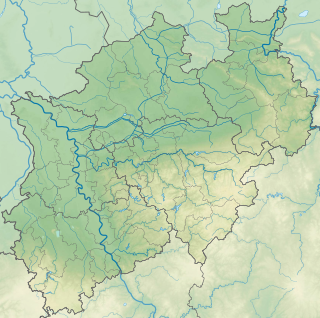Heiligenhauser Terraces
| Heiligenhauser Terraces | |||
|---|---|---|---|
| Aerial view of Heiligenhaus | |||
| Systematics according to | Handbook of the natural spatial structure of Germany | ||
| Greater region 1st order | Low mountain range threshold | ||
| Greater region 2nd order | Rhenish Slate Mountains | ||
| Main unit group | 33 → Süderbergland |
||
| About main unit | 337 → Bergisch-Sauerland lowlands |
||
| 4th order region (main unit) |
337 1 → Niederbergisch-Märkisches hill country |
||
| 5th order region | 337 1 .0 → Niederbergische Höhenterrassen |
||
| Natural space |
337 1 .01 → Heiligenhauser Terraces |
||
| Geographical location | |||
| Coordinates | 51 ° 19 '33 " N , 6 ° 57' 59" E | ||
|
|||
| local community | Heiligenhaus , Mettmann , Wülfrath | ||
| circle | Mettmann district | ||
| state | North Rhine-Westphalia | ||
| Country | Germany | ||
With Heiligenhauser terraces one is natural spatial unit (order number 337 1 .01) of the main unit via Bergisch-Sauerländisches lowlands called (atomic number 337).
It mainly comprises the urban area of Heiligenhaus in the Niederbergisches Land together with small parts of the north of Mettmann and the west of Wülfrath . In the north the natural area borders on the Ruhr valley (337 1 .2), in the south on the Mettmanner Loessterrassen (337 1 .00) and in the east on the Ruhr stratified rib land (337 1 .14), the Velberter Höhenrücke (337 1 .10) and the Wülfrather Kalkgebiet (337 1 .17).
The landscapes in the natural area include the Rinderbachtal (also called Vogelsangbach) and the Angerbachtal . The ridge between the two rivers is also a watershed between the river systems of the Ruhr and the Rhine , on which a medieval high road ran. The center of the city of Heiligenhaus, which emerged from a street village , lies on it . In the north, the Rhine terraces gradually merge into the Ruhr terraces.
The north-east of the Heiligenhauser Terraces consists of old diluvial Rhine terraces , the flat areas of which are heavily disrupted by the above-mentioned brooks. The loess soils are less thick here than those of the loess terraces in the southern part of the natural area. The arable soils are therefore interspersed with slate and greywackle rubble from the Devonian or Carboniferous basement.

